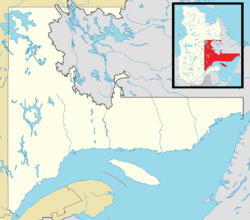Nutashkuan
Natashquan[1] | |
|---|---|
First Nations reserve | |
 | |
| Coordinates: 50°08′N 61°48′W / 50.133°N 61.800°W[2] | |
| Country | Canada |
| Province | Quebec |
| Region | Côte-Nord |
| Regional county | none |
| Formed | 1953 |
| Government | |
| • Chief | Réal Tettaut |
| • Federal riding | Manicouagan |
| • Provincial riding | Duplessis |
| Area | |
• Total | 1.19 km2 (0.46 sq mi) |
| • Land | 1.35 km2 (0.52 sq mi) |
| There is an apparent discrepancy between 2 authoritative sources. | |
| Population (2021)[4] | |
• Total | 915 |
| • Density | 678.5/km2 (1,757/sq mi) |
| Time zone | UTC−05:00 (Within the AST legislated time zone boundary but observes EST[5]) |
| • Summer (DST) | UTC−04:00 (EDT) |
| Postal Code | G0G 2E0 |
| Area code(s) | 418 and 581 |
Nutashkuan (INAC[6][2]) or Natashquan (CGNDB) (sometimes Natashquan 1) is a First Nations reserve in the Canadian province of Quebec, belonging to the Première Nation des Innus de Nutashkuan band. The reserve is located on the north shore of the Gulf of St. Lawrence at the mouth of the Natashquan River, 336 km (209 mi) east of Sept-Îles and has been accessible by Route 138 since 1996.
The reserve should not be confused with the adjacent but distinct township of Natashquan just to the north and east.
The community is serviced by a nursing station, community radio station, municipal water and sewer system, fire station, and an aboriginal police force.[7]
The site was mapped in 1684 by Louis Jolliet who called it Noutascoüan. It was subsequently spelled as Nontascouanne (1734), Natasquan (1831), Nataskwan (1844), Natashkwan (1846), Natosquan (1857), Nataskouan (1858), and taking its current form, Natashquan, circa 1895. This name, spelled Nutahkuant or Nutashkuan in the contemporary Innu language, is usually translated as "where the black bear is taken" or "where one hunts for bear."[8]
- ^ a b "Répertoire des municipalités: Geographic code 98806". www.mamh.gouv.qc.ca (in French). Ministère des Affaires municipales et de l'Habitation. Retrieved 6 June 2024.
- ^ a b "Nutashkuan". Geographical Names Data Base. Natural Resources Canada. Retrieved 18 August 2021.
- ^ First Nation details for the Nutashkuan First Nations at Indigenous and Northern Affairs Canada. Retrieved 18 August 2021.
- ^ a b Cite error: The named reference
SC2021was invoked but never defined (see the help page). - ^ National Research Council Canada – Time Zones & Daylight Saving Time Archived 17 March 2010 at the Wayback Machine
- ^ Reserve, settlement or village details for Nutashkuan Reserve at Indigenous and Northern Affairs Canada. Retrieved 18 August 2021.
- ^ "Natashquan First Nation". Aboriginal Community profiles. Indian and Northern Affairs Canada. Archived from the original on 13 June 2011. Retrieved 15 September 2010.
- ^ "Natashquan (Réserve indienne)" (in French). Commission de toponymie du Québec. Retrieved 15 September 2010.
